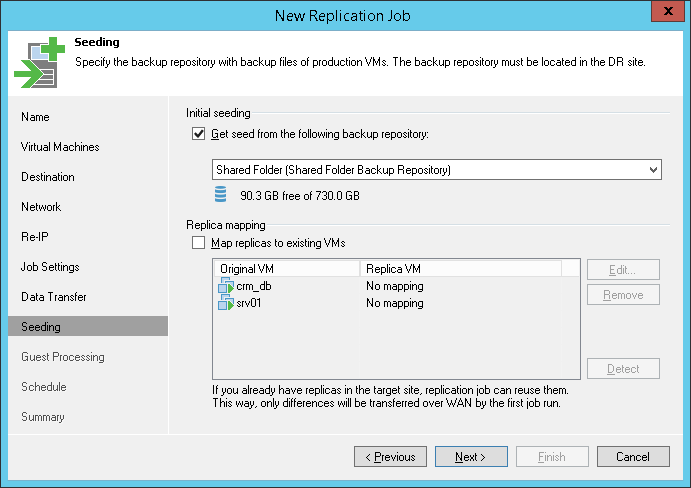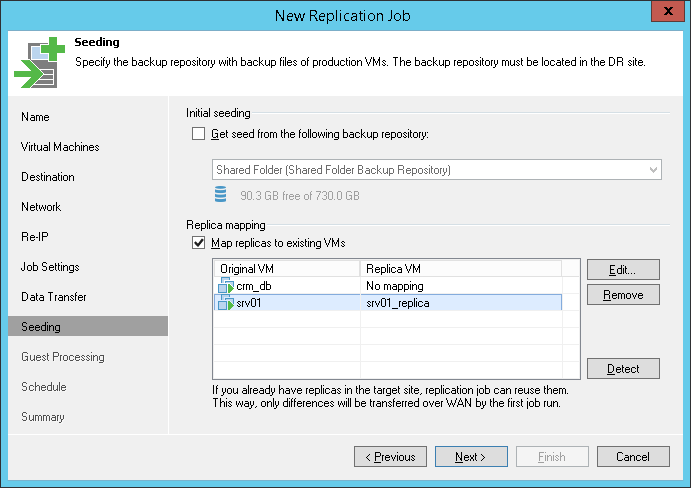 This is an archive version of the document. To get the most up-to-date information, see the current version.
This is an archive version of the document. To get the most up-to-date information, see the current version.Step 13. Define Seeding and Mapping Settings
The Seeding step is available if you have selected the Low connection bandwidth option at the Name step of the wizard. You can use this step to configure replica seeding and mapping for the replication job.
If you use replica seeding or mapping, make sure that you select correct backup infrastructure components for the job: source-side backup repository for metadata and backup proxies. It is recommended that you explicitly assign backup proxies in the production site and DR site. For more information, see Step 12. Specify Data Transfer Settings.
Configuring Replica Seeding
If you plan to replicate to a remote DR site over WAN or low-bandwidth network, you can use replica seeding. Replica seeding helps reduce the amount of VM data transferred over the network.
Replica seeding can be used if you have a backup for the replicated VM in the backup repository located in the DR site. In this case, you can point the replication copy job to this backup. During the first session of the replication job, Veeam Backup & Replication will use this backup file as a "seed". Veeam Backup & Replication will restore the VM image from the backup and register the VM replica on the target host. After that, Veeam Backup & Replication will synchronize the VM replica with the source VM. All subsequent incremental replication runs will be performed in the regular manner.
Before you start a replication job that uses replica seeding, you must perform a number of preparatory tasks:
- Create a backup (seed) of the VM that you plan to replicate. To do this, configure a backup job that points to an onsite backup repository. Run the job to create a full backup.
If you have previously created a backup containing all necessary VMs, there is no need to configure and run a new backup job.
For seeding, you can use any existing backup created with Veeam Backup & Replication. The backup must include VBK and VBM files. If you have a full backup and a chain of forward increments, you can use VIB files together with the VBK and VBM files. In this case, Veeam Backup & Replication will restore VMs from the seed to the latest available restore point.
- Copy the backup from the backup repository in the production site to a backup repository in the DR site. If you do not have a backup repository in the DR site, you will need to create one.
You can move the backup using a file copy job or any other appropriate method, for example, copy the backup to a removable storage device, ship the device to the DR site and copy backups to the backup repository in the DR site.
- After the backup is copied to the backup repository in the DR site, perform rescan of this backup repository. Otherwise, Veeam Backup & Replication will not be able to detect the copied backup.
When you complete the preliminary steps, you can configure replica seeding settings for the job.
- In the Initial seeding section, select the Get seed from the following backup repository check box.
- From the list of backup repositories, select the backup repository in the DR site to where the seed (the full backup) resides.
When you start the replication job, Veeam Backup & Replication will attempt to restore all VMs added to the job from the seed that you have specified. If a VM is not found in the seed, the VM will be skipped from replication.
|
You cannot use a backup located on the scale-out backup repository as a seed for a replication job. |

Configuring Replica Mapping
If a replica for the VM that you plan to replicate already exists on the target host in the DR site, you can use replica mapping. Replica mapping helps reduce the amount of VM data transferred over the network.
To use replica mapping, you must point the replication job to a VM replica on the host in the DR site. During the first session of the replication job, Veeam Backup & Replication will calculate the difference between the source VM and VM replica and copy necessary data blocks to synchronize the VM replica to the latest state of the source VM. All subsequent incremental replication sessions will be performed in the regular manner.
|
If there is no existing VM replica in the DR site, you can restore a VM from the backup and map it to the original VM. |
To set up replica mapping:
- Select the Map replicas to existing VMs check box.
- Click Detect. Veeam Backup & Replication will scan the destination location to detect existing VM replicas. If any matches are found, Veeam Backup & Replication will populate the mapping table.
If Veeam Backup & Replication does not find a match, you can map a VM to its VM replica manually. To do this, select a production VM from the list, click Edit and choose an existing VM replica. To facilitate selection, use the search field at the bottom of the window.
To break a mapping association, select the VM in the list and click Remove.
|
The mapping list does not display VMs added to the list of exclusions. For more information, see Step 5. Exclude Objects from Replication Job. |

Configuring Replica Seeding and Replica Mapping
You configure both replica seeding and replica mapping in the same replication job. For example, if a job includes 2 VMs, you can use seeding for one VM and map the other VM to an existing VM replica.
If replica seeding is enabled in the job settings, all VMs in the job must be covered with seeding or mapping. If a VM is neither available in the seed, nor mapped to an existing VM replica, it will be skipped from processing. And, on the contrary, if the same VM is available in the seed and mapped to an existing replica, replication will be performed using replica mapping as mapping has precedence over seeding.